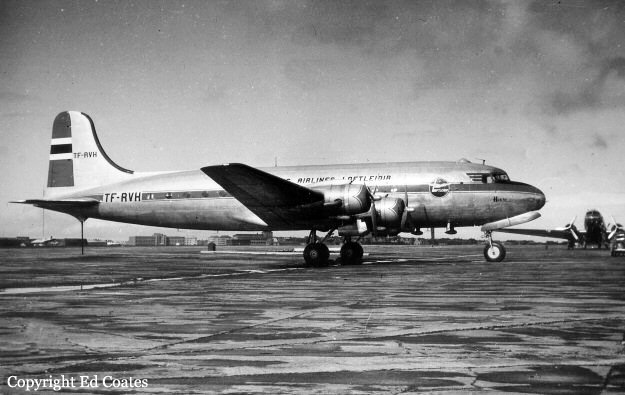Circumstances:
The C-54G, assigned to the Military Air Transport Service (MATS), 1701st Air Transport Wing at Malmstrom Air Force Base (AFB), Great Falls, Montana, was inbound from Ladd AFB, Fairbanks, Alaska, carrying 32 American servicemen and their dependents, and a crew of seven. At 0030LT, the pilot, Captain Albert J. Fenton, radioed the McChord air traffic control tower for field conditions and was informed that visibility was approximately three-quarters of a mile. Captain Fenton was directed to execute a wide left-hand turn and descend for a ground-controlled landing from the south. As the aircraft neared the field, a thick fog bank, rising 300 feet high, suddenly developed, reducing visibility to near zero. At 0048LT, Captain Fenton, now on final approach, decided to abort the landing and radioed the control tower that he was proceeding to Malmstrom AFB instead. Minutes later, witnesses telephoned the control tower and the Pierce County Sheriff’s Department to report a downed aircraft. The Skymaster crashed into an open field (now Wards Lake Park) approximately one mile north of McChord AFB and one-half mile east of S Tacoma Way between S 84th and S 88th Streets in the unincorporated community of Lakewood. It barely missed the Edgewood Park apartments, 35 four-family units built to ease the military’s housing shortage during the Korean War (1950-1953), and other nearby homes. Several people who saw the accident said the Skymaster was on fire before it crashed. Upon impact, the aircraft broke in two and exploded into flames. Bodies, personal belongings, packages and luggage were scattered around the crash scene for 200 yards. Most of the fire was in the forward section of the fuselage, the tail and aft section remaining almost intact. Some witnesses said they could hear the cries of people caught in the burning wreckage, but were helpless to render assistance. Meanwhile, fire and rescue teams from McChord AFB, Lakewood, and Tacoma rushed to the crash site and extinguished the fires in the fuselage and scattered debris. Using magnesium flares and flashlights, police and sheriff’s officers, firemen, and military personnel searched the smoldering, twisted wreckage, looking for victims. Of the 39 people aboard the C-54G, they found only three survivors: Airman Bobby R. Wilson, age 20, a member of the plane’s crew, Airman Curtis Redd, age 23, and Joseph M. Iacovitti, age 8, both passengers. Wilson, who had third-degree burns, internal injuries, and multiple skull fractures, died at Pierce County Hospital on Saturday, November 29. Redd was taken to St. Joseph Hospital in Tacoma in critical conditions with third-degree burns, but survived. Iacovitti was taken to Pierce County Hospital in serious condition with burns, broken legs and a fractured neck. He lived through the ordeal, but his parents, two brothers, and a sister died in the mishap, leaving him an orphan and the only surviving member of his family. Three other families were wiped out entirely.
Crew:
Benedict, John H., 20, Airman Second Class
Bentley, Patricia, 24, Airman Third Class
Bokinsky, Joseph H., 24, Staff Sergeant
Childers, Wilber C., 21, Airman Second Class
Fenton, Albert J., 29, Captain, pilot
Harvey, James D., 27, First Lieutenant, copilot
Wilson, Bobby R., 20, Airman Third Class.
Passengers:
U.S. Army:
Coons, Robert F., 22, Corporal
Galloway, Calvin, 18, Private First Class
Hockenberry, Denny L., 22, Sergeant
Hockenberry, Elda M., 21, spouse
Hockenberry, Susan E., 2, daughter
Hockenberry, Denise M., 1, daughter
Lebonitte, Joseph T., 23, Private First Class
Zeravich,Christoph, 24, Corporal
U.S. Air Force
Alsbury, Jack R., 21, Airman Third Class
Cook, Robert H., 20, Airman First Class
Farley, Donna L., 20, (spouse of Farley, Glen D., Staff Sergeant)
Iacovitti, Anthony R., First Lieutenant
Iacovitti, Dorothy E., 31, spouse
Iacovitti, Anthony F., 6, son
Iacovitti, John A., 4, son
Iacovitti, Barbara, 2, daughter
Johnson, Dwight P., 23, Airman Second Class
Morris, George E., 33, Master Sergeant
Morris, Anna D., 28, spouse
Morris, George E., Jr., 3, son
Morris, Geraldine A., 5, daughter
Niemi, Edwin, 35, Staff Sergeant
Parlett, Frederick D., 18, Basic Airman
Pickerel, Robert L., 22, Airman First Class
Smith, Raymond D., 24, Staff Sergeant
Swang, Marion E., 41, Major [incorrectly listed as Swann]
Weikum, Elmer, 23, Airman Second Class
Wells, Samuel R., 35, Master Sergeant
Wells, Margaret A., 33, spouse
Wells, Samuel R. III, 3, son
Survivors
Iacovitti, Joseph M., 8, (son of Dorothy and Anthony Iacovitti)
Redd, Curtis, 23, Airman Second Class.
Source:
http://www.koreanwar-educator.org/topics/airplane_crashes/c54_tacoma_19521128/p_c54_tacoma_11_28_52.htm









